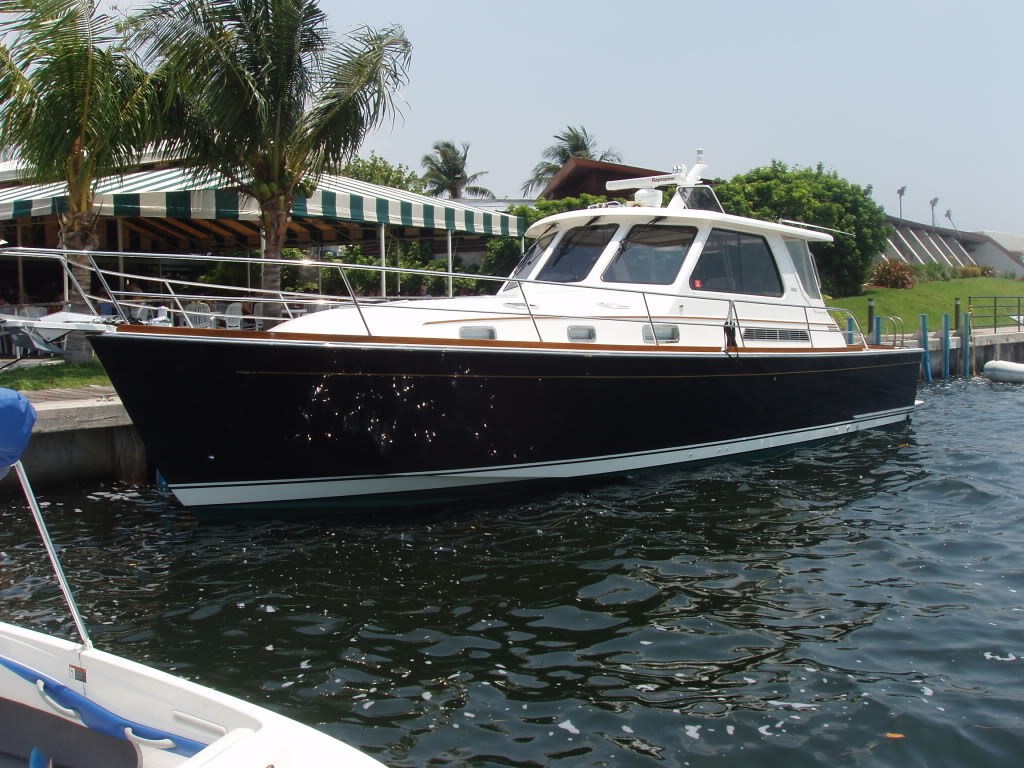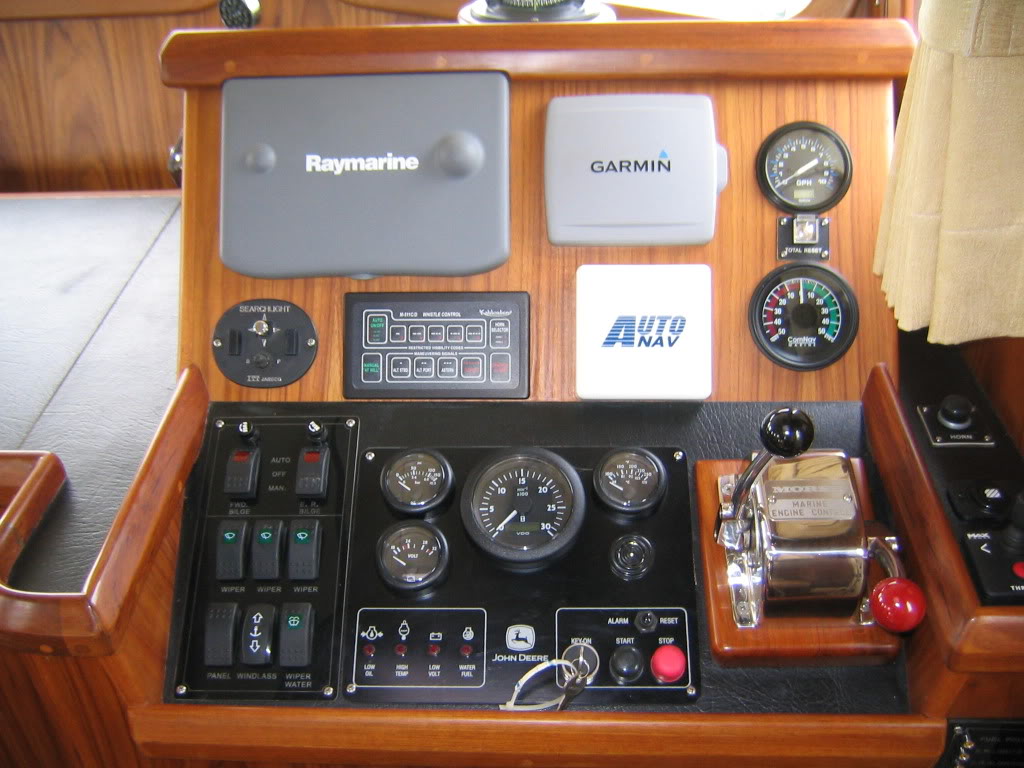You are using an out of date browser. It may not display this or other websites correctly.
You should upgrade or use an alternative browser.
You should upgrade or use an alternative browser.
Docking
- Thread starter jarod
- Start date
The friendliest place on the web for anyone who enjoys boating.
If you have answers, please help by responding to the unanswered posts.
If you have answers, please help by responding to the unanswered posts.
With my trawler, my best approach was steering and gearing. In and out of gear - no throttle.
I used to do it that way. Finally after years of watching tugs and lobsterboats and seine boats maneuver slickly and quickly when docking it finally dawned on me what I'd been watching but hadn't seen, and that's the use of power in close-in maneuvering, and sometimes lots of it.
So I started using power as a maneuvering tool a year or so ago and what a fantastic tool it is. It has brought a whole new dimension to our maneuvering that can make things easier, faster, and more controlled. I have a lot yet to learn with regards to using power in close-in maneuvering but since adding it to the "repertoire" we can do so much more under a much wider range of wind and current conditions than we could using shifters and rudders only.
skipperdude
Guru
There you go Marin.
All of what you said and three more things.
Practice, practice, practice.
The older you get the better you get.
sd
All of what you said and three more things.
Practice, practice, practice.
The older you get the better you get.
sd
psneeld
Guru
Spinning my boat 180 degrees in it's own length...even with a knot or so of current or 10-15 knots of wind is easy if I'm willing to use 1000-1200 rpm bursts to kick the stern where I need it. (maybe even more throttle if conditions dictate). If docking conditions are going to be too much more challenging...I tell the dockmaster I'm a single, no bow thruster and they put me someplace else.
Even though I can get tighter in worse conditions...they don't know that and appreciate the info and the lesser worry of making it easier on everyone.
Even though I can get tighter in worse conditions...they don't know that and appreciate the info and the lesser worry of making it easier on everyone.
Moonstruck
Guru
- Joined
- Nov 27, 2008
- Messages
- 8,276
- Location
- USA
- Vessel Name
- Moonstruck
- Vessel Make
- Sabre 42 Hardtop Express
Spring lines are your friend. Unless in an unusual situation, we put a spring line ashore first. It is an emergency brake, and can give better control of the boat.
If you will look carefully at the largest size of the attached photo, you will see 2 spring lines coiled and ready on the rail of Moonstruck. That is standard procedure for us.

If you will look carefully at the largest size of the attached photo, you will see 2 spring lines coiled and ready on the rail of Moonstruck. That is standard procedure for us.

Last edited:
bobc
Senior Member
Have you tried more speed? With a full keel, and a bit of water flowing over the rudder, you should be able to minimize the effects of wind by limiting it's contribution in both proportion and duration. Try coming in at a shallow angle with a bit of speed. Then use the rudder to get the boat's stern turning into the dock. Finally, back with a bit of power to stop both the forward momentum and the rotation. Usually you'll end up with a bit of drift in the direction of the dock, which I find helpful, especially when single-handling as this gives me time to get midships and get a line on.
Coming out with a bit more aggression might also help. Here, give a strong, short burst of reverse to get her moving out of the slip quickly, and then use short forward bursts with the rudder hard over to get her rotating as you clear the pier, with short, strong bursts of reverse to keep her backing. You should be able to leave the rudder hard over as it's probably not going to have much affect in reverse.
My sailboat had a small motor and prop, so I was never able to get away with simply shifting in and out of gear at idle. I also had to learn to apply power before I thought I needed it because the little one-lung diesel took a bit of time to respond to the throttle. When the currents were also working against me, I'd also walk the boat halfway out of the slip.
Coming out with a bit more aggression might also help. Here, give a strong, short burst of reverse to get her moving out of the slip quickly, and then use short forward bursts with the rudder hard over to get her rotating as you clear the pier, with short, strong bursts of reverse to keep her backing. You should be able to leave the rudder hard over as it's probably not going to have much affect in reverse.
My sailboat had a small motor and prop, so I was never able to get away with simply shifting in and out of gear at idle. I also had to learn to apply power before I thought I needed it because the little one-lung diesel took a bit of time to respond to the throttle. When the currents were also working against me, I'd also walk the boat halfway out of the slip.
Last edited:
Delfin
Grand Vizier
- Joined
- Jan 20, 2010
- Messages
- 3,820
Jarod, your boat sounds like my 36' Cape George cutter in terms of the underbody. It took me about 5 years (slow learner here), but I eventually discovered that I could turn her in her own length by putting the tiller over hard, throwing her into reverse and once the bow stopped turning in reference to a fixed point at the dock or on land, put her back into forward with some gas to get the boat to continue to rotate. Once I felt I was starting to move forward, back into reverse and by repeating this I could spin her around in her own length, without ever moving the rudder (turns out to be the key to the whole opeation).My bow does tend to blow off quite quickly if standing for anytime at all in any sort of wind. I usually have my two young girls (2 and 3 yrs old) screaming for mom behind me in the pilothouse as I come in and on occasion I will just tell mom to deal with the kids and I will single hand the boat in. There is also a fair amount of current in our marina which complicates the matter further. I vary my approach with the slow and easy taking the tranny in and out of gear at idle. The times I come in "hot" so to speak are to deal with a strong wind off the starboard bow or a strong current. I always prefer the slow and easy approach if its possible.
The reason for noting this is that slow and easy works sometimes, but not very well when docking a full keel sailboat that perhaps some on this thread haven't done all that much of. You need to be making some headway or the rudder is useless, so trying to visualize your situation, I would bring the vessel in, rotate her so I could approach the slip from a 30 degree angle or so, then power into the slip 'hot', using reverse and the rudder hard over to counter prop walk with prop wash against the rudder.
Getting out is a whole other story since you don't have any way on so can't do much other than fend off. Since full keel boats rarely back well, you're probably stuck with the fenders.
I've made the above technique work all the way up to an 85' 100+ ton river barge, docking with the current using just power with the rudder hard over. Have to come in hot, which can freak bystanders out a bit, but it works.
markpierce
Master and Commander
- Joined
- Sep 25, 2010
- Messages
- 12,557
- Location
- USA
- Vessel Name
- Carquinez Coot
- Vessel Make
- penultimate Seahorse Marine Coot hull #6
I love the layout of your panel. The ship's compass is smack in the middle of your view. Also, the Floscan is where it can be easily monitored. Well done!
Thanks. The builder customized the upper-panel layout based on my input.
GarryP
Senior Member
Jarod,
This article was very helpful to me http://www.his.com/~vann/KrgStuff/manuvrng.htm
Mark,
My compliments also on the panel. I saved a pic for my own remodel someday.
This article was very helpful to me http://www.his.com/~vann/KrgStuff/manuvrng.htm
Mark,
My compliments also on the panel. I saved a pic for my own remodel someday.
markpierce
Master and Commander
- Joined
- Sep 25, 2010
- Messages
- 12,557
- Location
- USA
- Vessel Name
- Carquinez Coot
- Vessel Make
- penultimate Seahorse Marine Coot hull #6
Garry, the guiding principle in designing the panel was to place instruments (radar display/GPS/electronic chart and searchlight control) on the left side (the Coot's helm position is starboard) so they are accessible to an assistant/lookout while those instruments which would be of less interest to the assistant but relevant to the helmsman (rudder indicator and fuel-consumption meter) are on the right side.
Similar threads
- Replies
- 46
- Views
- 3K
- Replies
- 33
- Views
- 2K

